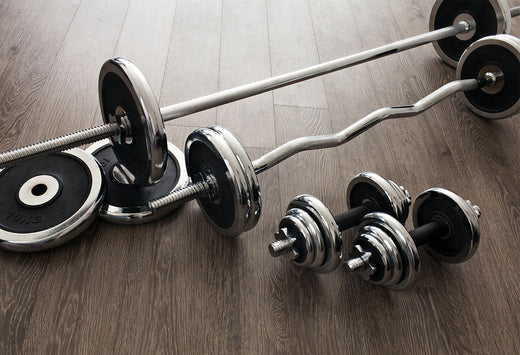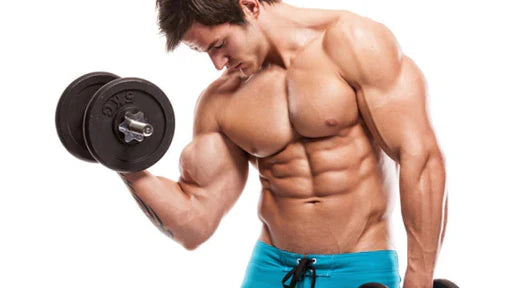Exercices de base avec haltères pour un torse plus mince, plus fort et plus défini

Sculpter sa poitrine :
Votre partenaire de gym vous dit qu'il veut faire des exercices pour les abdominaux. Qu'est-ce qui vous vient à l'esprit ? Si vous pensez exclusivement à votre ventre, vous n'êtes pas seul. Mais voilà : votre ceinture abdominale ne se limite pas à votre ventre. Certes, votre ventre en fait partie, mais ce n'est pas le tronc. Commencez-vous à comprendre ? Si votre objectif est d'avoir un ventre plat et de commencer à le sculpter, ou si vous voulez des abdos en béton, c'est un bon début. Mais nous voulons que vous regardiez au-delà de votre ventre.
Renforcer l'ensemble de votre ceinture abdominale vous aidera à obtenir un ventre plat, mais vous constaterez également une amélioration de vos mouvements et réduirez les risques de blessures. Pour ce faire, nous vous recommandons d'utiliser l'un des meilleurs équipements d'haltérophilie : les haltères. Découvrons les meilleurs exercices de gainage avec haltères et veillons à ce que vous ayez quelques exercices de gainage avec haltères pour commencer.
LES MUSCLES QUI CONSTITUENT VOTRE TRONC
Avant d'aborder les meilleurs exercices de gainage avec haltères, il est important de décomposer tous les muscles qui composent votre ceinture abdominale. (N'oubliez pas qu'elle ne se limite pas à votre ventre.) Comprendre la musculature de votre ceinture abdominale renforcera votre connexion esprit-muscle. Cela peut se traduire par de meilleures performances, et donc de meilleurs résultats.
Grand droit de l'abdomen : Tout le monde connaît le grand droit de l'abdomen. En fait, ce muscle constitue à lui seul le tronc. Le grand droit de l'abdomen est communément appelé muscles abdominaux . Ce muscle est situé à l'avant et au centre, partant du plexus solaire et descendant jusqu'à l'aine.
Le transverse de l'abdomen : Sous le grand droit se trouve une couche de tissu musculaire profond appelée le transverse de l'abdomen. Bien qu'il joue un rôle essentiel dans les mouvements de rotation et les contractions abdominales, il n'est pas autant mis en avant que le grand droit (même si nous pensons qu'il devrait l'être). Apprendre à activer et à contrôler ce muscle peut faire une différence considérable dans vos résultats.
Obliques externes : Placez vos mains sur vos côtes. Ce sont vos obliques externes. Placés sur les côtés du torse, vos obliques participent aux mouvements de rotation. Ils sont tout aussi importants pour les mouvements antirotationnels ou pour lutter contre la traction. Un bon exemple est l'écarquillage debout à une main.
Obliques internes : Tout comme le grand droit et le transverse, ce sont les obliques externes qui retiennent l'attention. Sous les obliques externes se trouvent les obliques internes. Comme leurs homologues externes, les obliques internes assurent les mouvements de torsion et de rotation de base, ainsi que les mouvements antirotationnels.
Muscles érecteurs du rachis : Enfin, nous avons les muscles érecteurs du rachis. Ces muscles sont situés dans le dos et remontent le long de la colonne vertébrale. Ils complètent le tronc, assurant l'équilibre et la stabilité des mouvements de rotation.
Ok, pourrais-tu suivre un cours d'anatomie maintenant ?
Voici quelques exercices : enfilez votre t-shirt et regardez-vous dans le miroir. Examinez votre ceinture abdominale et entraînez-vous à contracter chaque groupe musculaire que nous avons abordé. En renforçant votre connexion esprit-muscle, vous pouvez améliorer vos performances globales. Et comme nous l'avons mentionné plus haut, plus vos performances sont bonnes, plus vous activez les muscles ciblés, meilleurs sont les résultats.
MEILLEURS EXERCICES DE BASE AVEC HALTÈRES
Vous trouverez ci-dessous une liste des exercices de gainage avec haltères les plus efficaces. Pour faciliter la création de vos propres exercices, nous avons classé les exercices pour un ventre plat selon les muscles ciblés. Nous verrons ensuite comment combiner tous ces exercices pour développer votre gainage.
Grand droit de l'abdomen
- V-Up avec haltères
- Crunch allongé avec haltères
- Atteindre et rentrer
- Élévation des jambes allongée
- Crunch inversé avec haltères
- Woodchopper (répertorié deux fois car il cible le grand droit de l'abdomen et les obliques)
transverse de l'abdomen
- Insecte mort en forme d'haltère
- Chien oiseau avec haltères
- Maintien du corps creux avec haltères
- Abdominaux avec haltères BOSU
- Vacuum (Ce n'est pas un exercice avec haltères, mais c'est le roi des exercices abdominaux transversaux.)
Obliques
- Flexion latérale avec haltères
- Planche latérale avec haltères
- Rotations de planche latérale avec haltères
- Twists russes
- bûcheron
Muscles érecteurs du rachis
- Soulevés de terre avec haltères
- Soulevés de terre roumains
- Extensions du dos avec haltères
- Superman avec haltères
- Valise de transport d'haltères
COMMENT CRÉER VOS PROPRES EXERCICES DE MUSCULATION AVEC HALTÈRES
Voici quelques conseils pour créer vos propres exercices abdominaux basés sur les exercices que nous avons répertoriés ci-dessus.
Choisissez vos exercices
Cela dépendra de la fréquence à laquelle vous souhaitez cibler vos abdominaux chaque semaine. Nous vous recommandons d'avoir une « Journée Abdominale » dédiée ou d'intégrer des exercices à vos entraînements existants trois fois par semaine. Choisissez vos exercices en fonction de ceux que vous pratiquez déjà ce jour-là. Par exemple, si vous vous concentrez sur vos jambes, vous sollicitez probablement les ischio-jambiers ; vous pouvez donc facilement intégrer des soulevés de terre avec haltères. Décomposez l'exercice de manière à inclure un ou deux exercices abdominaux dans quelques-uns de vos entraînements actuels. Essayez de répartir les différents muscles abdominaux sur différents jours. Vous pouvez également consacrer une journée entière ou la majeure partie d'une séance à vos abdominaux. Vous pouvez ensuite effectuer un à trois exercices pour chaque partie de vos abdominaux.
Séries et répétitions
Cela dépend de la charge utilisée. En général, plus vous utilisez de poids, moins vous effectuerez de répétitions et plus de séries. Moins vous utilisez de poids, plus vous ferez de répétitions et moins vous ferez de séries. Des poids plus lourds sont plus efficaces pour développer la musculature abdominale. Des poids plus légers sont plus efficaces pour la définition.
Choisissez votre temps de repos
Si vous souhaitez brûler plus de calories et maintenir votre rythme cardiaque élevé, réduisez vos pauses, sans pour autant nuire à votre posture et à votre technique. Un repos de 60 secondes est la norme. Si vous utilisez des poids plus lourds, privilégiez un repos de 90 à 120 secondes.
Choisissez votre méthodologie
Si vous avez une bonne expérience en haltérophilie, nous vous recommandons de modifier la méthodologie de vos entraînements. Par exemple, vous pouvez superposer un de vos exercices actuels avec un exercice de gainage, comme le soulevé de terre roumain et un sit-up avec haltères.
Découvrez comment améliorer votre entraînement avec différentes méthodologies dans notre article sur la façon de sortir d'un plateau d'haltérophilie .
EXERCICES DE BASE AVEC HALTÈRES POUR COMMENCER
Même si vous savez déjà comment réaliser vos exercices de gainage avec haltères, nous souhaitons vous aider à démarrer. Vous trouverez ci-dessous trois exercices d'abdominaux avec haltères que vous pouvez utiliser dès aujourd'hui. Comme indiqué précédemment, chaque exercice peut être réalisé seul ou réparti entre deux exercices du haut du corps.
Exercices abdominaux avec haltères pour débutants
Il s'agit d'un entraînement de base, sans fioritures, pour les abdominaux. Nous vous conseillons de vous concentrer sur une exécution parfaite de chaque répétition. Ces mouvements vous aideront à construire une base solide pour gagner en force et entreprendre des exercices abdominaux et de gainage plus avancés. Effectuez toutes les répétitions de chaque série. Accordez-vous entre 90 et 120 secondes de repos par série.
- Crunch allongé avec haltères : 3 séries de 10 à 15 répétitions
- Crunch inversé avec haltères : 2 x 10 – 15
- Dumbbell Bird Dog : 2 x 10 – 15
- Flexion latérale avec haltères : 2 x 10 – 15
- Superman avec haltères : 2 x 8 – 15
Entraînement intermédiaire avec haltères
Même principe que l'entraînement pour débutants, sauf que nous utilisons des exercices plus difficiles et raccourcissons les temps de repos. Essayez de ne vous reposer que 60 secondes entre les séries.
- Élévation des jambes allongée : 3 séries de 10 à 15 répétitions
- Dumbbell Bird Dog : 2 x 10 – 15
- Vide : 2 x 10 – 15 secondes
- Planche latérale avec haltères : 2 x 8 – 15
- Torsades russes : 2 x 10 – 15
- Extensions du dos avec haltères : 2 x 8 – 15
- Port d'haltères dans une valise : 2 x 20 à 25 secondes
Entraînement avancé des abdominaux avec haltères
Nous vous proposons d'utiliser la méthode des super-sets pour cet entraînement avancé du tronc. Il consiste à effectuer un exercice de tronc, puis à passer immédiatement au suivant, sans pause. C'est une méthode de musculation à haute intensité ; si vous vous épuisez, accordez-vous une pause plus longue. Nous préférons vous laisser reposer plus longtemps plutôt que de commettre une erreur et de vous blesser à cause de la fatigue.
Nous avons associé les exercices que vous effectuerez les uns après les autres et leur avons attribué la même lettre. Mais attention : vous effectuerez un mouvement lourd suivi d'un mouvement léger. Vous le saurez grâce au nombre de répétitions qui vous est attribué. N'oubliez pas : moins de répétitions signifie plus de poids ; plus de répétitions signifie moins de poids.
- A : Soulevés de terre avec haltères : 3 séries de 8 à 15 répétitions
- A : Bûcheron : 3 séries de 20 répétitions
- B : BOSU Abdominaux avec haltères : 2 x 8 – 12
- B : Atteindre et rentrer : 2 x 15
- C : Rotations de la planche latérale avec haltères : 2 x 8 – 15
- C : V-Up avec haltères : 2 x 8 – 15
SCULPTEZ VOTRE VENTRE AVEC DES EXERCICES DE BASE AVEC HALTÈRES
Nous adorons les haltères, surtout pour développer une ceinture abdominale forte et définie. Si vous n'en avez pas, ce n'est pas grave. La plupart des exercices mentionnés ci-dessus peuvent être réalisés sans haltère. Dès que vous en avez l'occasion, n'hésitez pas à en ajouter un pour augmenter la difficulté.
En conclusion, comprendre la complexité de vos muscles abdominaux et intégrer divers exercices de gainage avec haltères peut grandement améliorer votre parcours de remise en forme. Renforcer l'ensemble de votre ceinture abdominale, y compris les grands droits, les muscles transverses, les obliques et les muscles érecteurs du rachis, vous aide non seulement à obtenir un ventre plat et des abdominaux dessinés, mais améliore également vos mouvements et réduit les risques de blessures.
En suivant les exercices et entraînements de gainage avec haltères suggérés, vous développerez une connexion musculaire et mentale forte et optimiserez vos performances en salle de sport. Que vous soyez débutant, intermédiaire ou confirmé, ces exercices s'adaptent à différents niveaux et objectifs.
N'oubliez pas que la régularité est essentielle pour obtenir des résultats durables. Choisissez les exercices, les séries et les répétitions adaptés à votre condition physique et personnalisez vos entraînements en conséquence. Veillez toujours à maintenir une posture et une technique correctes pour tirer le meilleur parti de chaque exercice.
Si ce guide vous a été utile, n'hésitez pas à le partager avec vos amis et abonnés sur les réseaux sociaux comme Instagram et Facebook . Rejoignez notre communauté pour plus de conseils fitness, de routines d'exercices et de contenu santé. Ensemble, entamons un voyage vers un gainage musculaire et un mode de vie plus sain et en meilleure forme ! Restez motivé, persévérez et continuez à repousser vos limites.


